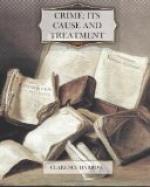Disease and ill health, when found so generally, are in themselves indications of a defective system, and such machines are constantly exposed to temptation. Their needs are ever present and their poverty great. Sickness and disease weaken or destroy such inhibitions as the unfortunate are able to build up, and they readily yield to crime.
XXV
THE GOOD IN CRIMINALS
The criminal is confronted in court with an indictment charging him with a violation of the law. He is a human being, like all others, neither perfect nor entirely worthless. He has some tendencies and inclinations which the world calls good for lack of a better term, and some that it calls bad for the same reason. In this he is like the jury and the judge. The strength of the different tendencies is not the same in any two machines. The judge and jury are interested in determining whether he is good or bad; that is, better or worse than they themselves. In theory he is tried on the charges contained in the indictment.
In most cases by a constant stretching of the rules of evidence his whole life may be involved. That is, proof may be offered of any act of delinquency that constituted a violation of the law, if in any way similar, or in any way connected with the one charged in the indictment. He cannot meet these charges by proving the acts of kindness and charity and real worth that are rarely absent in any life. The proceedings show how bad he is, not how good. He may be able to call witnesses to show that up to the time of the bringing of the indictment his reputation for honesty was good; but he cannot show that he supported his grandmother, or helped his aunt, or educated his younger brother, or gave his money to the poor. All the good is irrelevant to the issue. This does not prove that he did not commit the act. It might clearly prove whether on the whole he should go to jail. Through this process he feels that the law and proceedings are unfair and that he is condemned, when, in fact, he is as good as those who judge him. Neither can he show the circumstances that hedged in his way nor the equipment with which he entered life. Under the legal theory that he is “the captain of his soul,” these are not material to the issue. Neither can he show the direct motive that caused the conduct. It may have been a motive that was ideal, but the question involved is, did he violate the law?




